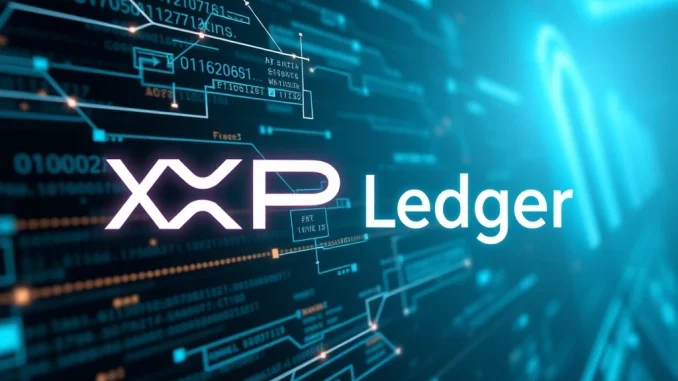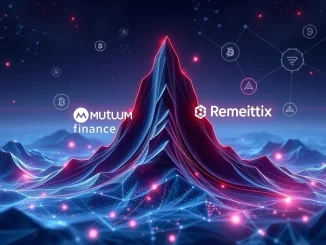
For anyone invested in the world of digital assets, the integrity of a blockchain’s historical record is paramount. Recent discussions around the missing early ledgers on the XRP Ledger have sparked considerable debate. Now, Ripple’s Chief Technology Officer, David Schwartz, has stepped forward to provide a comprehensive explanation, aiming to put data integrity concerns to rest. This clarification sheds light on the complexities of early blockchain development and Ripple’s approach to maintaining a robust, efficient ledger.
XRP Ledger and the Mystery of Missing Data
The core of the recent discussion revolves around a gap in the XRP Ledger‘s historical record. Specifically, the first 32,000 ledgers are absent, with the public record beginning at Ledger 32,570. This absence has led to various theories, from intentional deletion to technical failure. The community’s questions were valid: What caused this gap? Was critical information lost? And what does this mean for the ledger’s overall reliability?
Ripple CTO Addresses the Gap: A Bug, Not a Cover-up
David Schwartz, the Ripple CTO, directly addressed these concerns. He clarified that the missing data was not a result of malicious intent or a cover-up. Instead, it stemmed from an early software bug during the XRP Ledger’s developmental testing phase. This bug led to the loss of approximately ten days’ worth of ledger data. Schwartz explained that the decision not to reset the ledger was a pragmatic one. Resetting would have erased subsequent, more valuable transaction history, which was deemed far more critical to preserve than the incomplete early data. This highlights a common dilemma in blockchain development: balancing the desire for a perfect historical record with the practicalities of system stability and ongoing functionality.
Key Takeaways from the CTO’s Explanation:
- The missing ledgers resulted from an early software bug during development.
- Approximately ten days of data were lost.
- Resetting the ledger to recover this data was not feasible, as it would have discarded more valuable, subsequent transaction history.
- The XRP Ledger was designed for availability and speed, not infinite retention of every byte of historical data.
Understanding Blockchain Data Management: Speed vs. History
Schwartz’s explanation underscores a fundamental design philosophy of the XRP Ledger: prioritizing availability and speed over exhaustive historical preservation. This approach to managing blockchain data is not unique to XRPL. Many major blockchains, including Bitcoin and Ethereum, employ pruning strategies to optimize storage and performance. As a blockchain grows, retaining every single byte of historical data becomes computationally intensive and resource-heavy. Therefore, developers often make trade-offs, ensuring the integrity of recent and relevant data while allowing older, less critical data to be less accessible or pruned.
However, the visibility of such gaps in a public ledger system inevitably sparks debate. For the XRP Ledger, its relatively smaller size compared to giants like Bitcoin amplifies scrutiny over data accessibility, especially when considering early allocations.
The Debate Over XRP Transparency and Early Allocations
While the technical explanation for the missing ledgers addresses concerns about data integrity, it naturally leads to questions about XRP transparency, particularly regarding the pre-minted tokens. Roughly 55% of all XRP tokens were pre-mined in 2012, with a significant portion held by Ripple and its partners. Critics argue that the inability to trace these early transactions could fuel skepticism about decentralization and regulatory compliance.
Ripple has consistently stated that it has not engaged in market dumping, instead distributing tokens through partnerships and sales. To enhance transparency, Schwartz pointed to tools that allow users to reconstruct historical data using cryptographic proofs, though he cautioned that these methods require access to archived nodes and cannot fully replicate the original ledgers. The inability to independently verify early allocations remains a point of contention for some, highlighting the ongoing dialogue needed between developers, users, and regulators.
Ensuring Crypto Data Integrity in Decentralized Systems
The discussion around the XRP Ledger’s missing data is a microcosm of broader challenges in maintaining crypto data integrity within decentralized systems. Blockchain technology promises immutable records, yet practical implementation often involves compromises for scalability and performance. Ripple’s proactive communication about this ledger gap is a positive step, reinforcing trust and accountability in blockchain governance. It demonstrates a commitment to addressing technical challenges publicly, aligning with broader industry trends.
Moving forward, the focus for Ripple and the XRP Ledger community remains on optimizing ledger performance while preserving the integrity of existing transaction history. This incident serves as a reminder that even in decentralized systems, technical pragmatism often intersects with expectations of perfect transparency. Continuous dialogue and infrastructure improvements are essential for the evolution and acceptance of blockchain technology.
Conclusion
The clarification from Ripple CTO David Schwartz regarding the missing early XRP Ledger data is a significant development. It provides a technical explanation for a long-standing mystery, attributing it to an early software bug rather than intentional deletion. While this explanation mitigates concerns about data manipulation, it underscores the inherent trade-offs in blockchain design—balancing speed and availability with exhaustive historical preservation. The ongoing discussion highlights the importance of transparency, particularly concerning pre-mined assets, and the continuous need for open communication between blockchain developers, users, and regulators to build trust and ensure the long-term health of decentralized ecosystems.
Frequently Asked Questions (FAQs)
Q1: Why are the first 32,000 ledgers missing from the XRP Ledger?
The first 32,000 ledgers are missing due to a software bug encountered during the XRP Ledger’s early developmental testing phase. This bug led to the loss of approximately ten days’ worth of ledger data.
Q2: Why didn’t Ripple reset the XRP Ledger to recover the missing data?
Ripple CTO David Schwartz explained that resetting the ledger was not feasible because it would have resulted in the loss of subsequent, more critical transaction history. Preserving the existing, more valuable data was prioritized over recovering incomplete early data.
Q3: Does this issue affect the security or integrity of current XRP transactions?
No, the missing early ledgers do not affect the security or integrity of current XRP transactions. The XRP Ledger prioritizes availability and speed, and its design ensures the integrity of existing and ongoing transaction history.
Q4: How does this situation relate to pre-minted XRP allocations?
The inability to fully trace early transactions due to the missing ledgers has fueled some skepticism regarding the transparency of pre-minted XRP allocations (approximately 55% of all XRP tokens were pre-mined). While Ripple maintains it has not engaged in market dumping, critics seek independent verification of these early distributions.
Q5: Are similar data pruning strategies used by other major blockchains?
Yes, similar data pruning and optimization strategies are employed by other major blockchains, including Bitcoin and Ethereum. It’s a common practice in blockchain development to balance the need for historical data with storage optimization and performance requirements.
Q6: How can users verify historical XRP Ledger data if some is missing?
While the original ledgers cannot be fully replicated, Ripple has provided tools that allow users to reconstruct historical data using cryptographic proofs. However, these methods typically require access to archived nodes and may not fully replicate every detail of the original missing ledgers.



